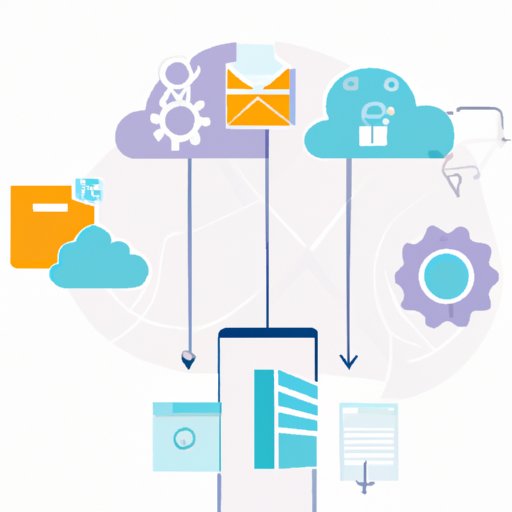Introduction
Technology outsourcing is the process of transferring technology-related tasks or functions to an external provider. It involves the use of external resources to manage and execute projects that are typically managed internally. Outsourced services can range from basic IT support to more complex tasks such as software development, data management, and web and mobile development. Organizations often outsource technology services to reduce costs, access expertise, and increase efficiency.

Types of Technology Outsourcing Services
Organizations may outsource a variety of technology services depending on their needs. Some of the most common types of technology outsourcing services include:
IT Infrastructure Services
IT infrastructure services refer to the underlying technology that enables operations within an organization. Examples of IT infrastructure services include network setup, server maintenance, and storage solutions. These services are typically outsourced to third-party providers who specialize in IT infrastructure.
Software Development
Software development covers a wide range of activities related to developing and maintaining software applications. These activities include designing, coding, testing, and debugging programs. Software development services are often outsourced to specialized firms who have the necessary expertise and resources to develop custom software solutions.
Data Management
Data management refers to the process of collecting, organizing, storing, and analyzing data. Organizations may outsource data management services to third-party providers who can provide specialized tools and technologies for managing large amounts of data. This helps organizations save time and money by avoiding the need to invest in expensive hardware and software.
Web and Mobile Development
Web and mobile development involve creating websites and mobile applications. This includes designing, coding, and deploying web and mobile solutions. Organizations may outsource web and mobile development services to third-party providers who have the expertise and resources needed to build custom solutions.
Cloud Computing
Cloud computing is the delivery of computing services over the internet. These services include storage, networking, databases, analytics, and more. Organizations may outsource cloud computing services to third-party providers who can provide access to cloud-based solutions and resources.
Pros and Cons of Outsourcing Technology
Outsourcing technology services can provide numerous benefits to organizations, but it also comes with some risks. It is important to understand both the advantages and disadvantages of outsourcing technology before making a decision.
Pros
There are several advantages to outsourcing technology services:
- Cost Savings: Outsourcing technology services can help organizations reduce labor costs and avoid capital expenditures. By outsourcing, organizations can benefit from economies of scale and access resources at a lower cost than if they were to manage those services in-house. According to a study by the Hackett Group, companies that outsource technology services can save up to 40 percent in costs compared to companies that manage those services internally.
- Access to Expertise: Outsourcing technology services can give organizations access to specialized expertise and resources that may not otherwise be available. Third-party providers can provide access to experienced professionals with specific skillsets that can help organizations achieve their goals more quickly and efficiently.
- Increased Efficiency: Outsourcing technology services can help organizations improve operational efficiency by freeing up internal resources and allowing them to focus on core activities. By outsourcing non-core activities, organizations can reduce overhead costs and redirect their efforts towards more strategic objectives.
Cons
However, there are also some drawbacks to outsourcing technology services:
- Loss of Control: When outsourcing technology services, organizations must relinquish control to the third-party provider. This can be challenging for some organizations, as they may not be comfortable relying on an external provider for critical functions.
- Quality Issues: Quality issues can arise when outsourcing technology services. Organizations must ensure that the third-party provider has the necessary experience and resources to deliver high-quality results. Otherwise, the organization may end up with subpar products or services.
- Security Risks: Outsourcing technology services can also present security risks. Organizations must ensure that the third-party provider has adequate security measures in place to protect sensitive data and prevent unauthorized access.

Cost Savings Associated with Technology Outsourcing
Technology outsourcing can help businesses save money in a number of ways:
Reducing Labor Costs
Outsourcing technology services can help organizations reduce labor costs by eliminating the need to hire and train additional staff. This can result in significant cost savings, especially for small businesses that may not be able to afford the cost of hiring full-time employees.
Avoiding Capital Expenditures
Outsourcing technology services can also help organizations avoid costly capital expenditures. Instead of investing in expensive hardware and software, organizations can pay for services on an as-needed basis. This can help organizations save money in the long run.
Leveraging Economies of Scale
By outsourcing technology services, organizations can benefit from economies of scale. Third-party providers can often provide services at lower costs due to their larger scale of operations. This can result in significant cost savings for organizations.
Challenges of Outsourcing Technology
Outsourcing technology services can present some challenges, such as cultural, language, and time zone differences. Organizations must be aware of these potential issues and take steps to mitigate them.
Cultural Barriers
Cultural barriers can arise when outsourcing technology services. Organizations must be mindful of cultural differences and take steps to ensure that communication is clear and effective. This may require additional effort on the part of the organization and the third-party provider.
Language Barriers
Language barriers can also be an issue when outsourcing technology services. Organizations should make sure that the third-party provider is fluent in the language they are providing services in. This will help ensure that communication is effective and efficient.
Time Zone Differences
Time zone differences can also pose a challenge when outsourcing technology services. Organizations must be aware of the time zone differences and plan accordingly to ensure that deadlines are met and expectations are met.

Best Practices for Implementing Technology Outsourcing
Organizations should follow certain best practices when outsourcing technology services to ensure successful implementation:
- Establish Clear Objectives and Expectations: Organizations should define clear objectives and expectations for the project and communicate them to the third-party provider. This will help ensure that the project is completed according to the organization’s specifications.
- Develop a Comprehensive Plan: Organizations should develop a comprehensive plan that outlines the scope of the project, timeline, budget, and other details. This will help ensure that the project is completed on time and within budget.
- Set Up Effective Communication Channels: Organizations should set up effective communication channels with the third-party provider to ensure that all parties are informed of progress and any changes. This will help ensure that the project runs smoothly.
- Monitor Progress Regularly: Organizations should monitor the progress of the project regularly to ensure that it is progressing as expected. This will help identify any potential issues early on and allow for corrective action if necessary.
Conclusion
Technology outsourcing can provide numerous benefits for organizations, including cost savings, access to expertise, and increased efficiency. However, it also comes with some risks, such as loss of control, quality issues, and security risks. Organizations should take these considerations into account when deciding whether to outsource technology services. Additionally, organizations should follow certain best practices to ensure successful implementation.
(Note: Is this article not meeting your expectations? Do you have knowledge or insights to share? Unlock new opportunities and expand your reach by joining our authors team. Click Registration to join us and share your expertise with our readers.)
